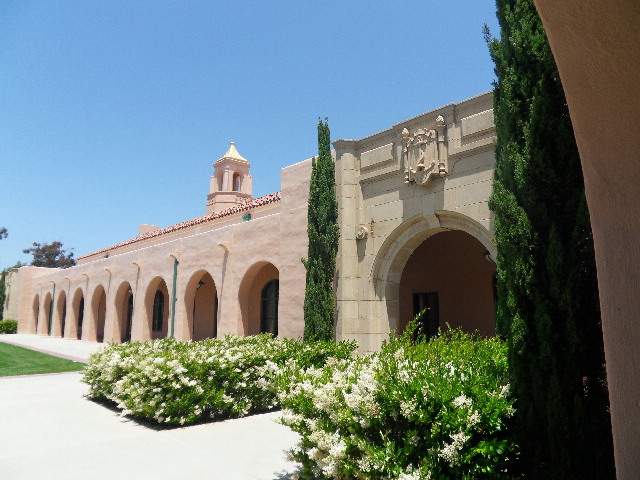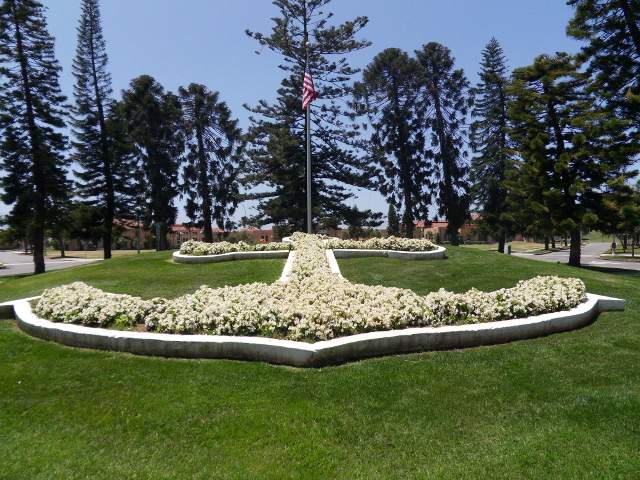Once a giant naval training base, Liberty Station has become a destination for locals who run, bike, and walk their dogs along the landscaped trails. They eat at the restaurants and shop at chain and specialty stores.
But what will really draw tourists is Liberty Station’s expanding cultural district. The 28 park-like acres of NTC Promenade contain 26 historic buildings, which are being restored to Spanish Colonial Revival-style glory. So far, nine are renovated. The city-mandated project calls for the buildings to be filled with small businesses, nonprofits and arts organizations. Already a quilt museum, several dance companies, art societies, and small businesses have opened. Stone Brewing will draw beer lovers when it opens later in the year.
“It’s on the cusp,” Jesse Brown told me recently while I surveyed a case of handmade chocolates, some made with champagne or topped with gold dust. Brown and his wife Tess co-own Chi Chocolat, which moved to Liberty Station three years ago from the Little Italy neighborhood. “It’s one of the most important areas to come visit as a consumer,” Brown said.
When you visit, I recommend the chocolate made with curry powder and toasted coconut.

History: The Navy and Me
Back in 1923, the Naval Training Station opened in San Diego as the new home for the Pacific Fleet. Over the next 74 years, more than 1.75 million sailors trained on the base, forever changing their lives and the city of San Diego.
The base also affected my life, as a young girl growing up directly across the street. While the military is designed to protect the country, I didn’t understand that at the time. Sailors were by turns annoying, comical, or menacing. Annoying when they threw their beer cans all over the busy street and passed out in our ivy. Comical when Mom caught them in her headlights and they froze, halfway down the chain-link fence as they snuck off the base at night. And menacing when, as a teenager, I’d take a shortcut up some neighborhood steps and come across a half dozen of them, lounging with their legs far apart, passing a joint, blocking my way.
Growing up across the street from one of the world’s major naval training bases, a young girl is not shielded from the grittier side of life. Even at twelve, I could not walk out my door without an assault of honks, hoots, and hollers. From a very early age I understood why the scantily clad ladies in convertibles followed the mobile check cashing vans on navy payday. I’m sure my experiences are common to many young girls who grew up next to a base full of thousands and thousands of pent-up young military men.
Access Denied
Living across from the base was like living on the edge of the world. The navy owned 558 acres of land, enclosed by a tall fence, and closed to civilians since World War II. It aggravated me that this huge tract of land was off limits.
I moved away when I was eighteen, but my parents lived on in the same house. As the years passed, I grew older than the sailors, whose average age hovered around nineteen. I started to age out of their hoots and whistles. As I lived in different places and met people of all ages, I began to understand the history of the place. I met many old guys who fondly remembered training at NTC back in World War Two, or the years since. The acreage across the street from my parents’ house on Rosecrans Street had played a huge role in world affairs, by training men and women who took part in 70 plus years of international naval activities.
Birth of Liberty Station

In 1997, under President Clinton’s administration, the base closed, its future in question. To me, this was shocking news. When I visited my family, the gate was open and I could cross the street into the old base for the first time.
My favorite part is how the original builders worked naval details into the architecture. Walking down Spanish covered walkways, I look up and see anchors carved in relief over doorways. Blue, green and yellow tiles in nautical patterns decorate other entrances. Inside Gate One, where all new recruits entered for decades, flowers are cultivated in the shape of an enormous anchor. The North Chapel has amazing stained glass windows of Jesus protecting sailors at sea.
The land runs all the way to a channel of San Diego Bay. The landscaping showcases plants that thrive in San Diego, such as birds of paradise, colorful succulents and bougainvillea. Walking trails wander along the bay. Dogs and children play in small parks and grassy fields.
Neversail
One of the first things I wanted to see on the base was the USS Recruit. This 2/3 scale model of a destroyer escort has long been nicknamed the Neversail. While it looks like a ship, it’s technically a building with doors clearly visible in its sides. Before the base closed, civilians could only glimpse the Neversail as they crested Harbor Drive, motoring toward Spanish Landing. To my childhood self, that boat-shaped building was compelling. I’d always wanted to inspect it up close.

The Neversail, commissioned in 1949, is the navy’s only officially commissioned fake ship. After 40 years of service as a training ship, the 233-foot long Neversail won recognition as a state landmark in 2005. Rumor has it that the ship/building may be opened as a museum someday. I hope so, because I would love to have a look inside.
While I took notes from the plaque, a man and his dog approached me. When I told him I was writing about NTC’s conversion, he told me his story.
One Recruit’s Story
Wes Danskin was drafted in 1973, a young man with “long hair and attitude.” Danskin only trained on the Neversail for one day, but had plenty of memories about the base. “The first day they remove your hair,” Danskin told me. “They take all your personal effects. Nothing’s left from your prior life. Then comes a couple of weeks of brainwashing and criticism from your drill instructor,” he said. “There’s a constant verbal barrage about your hair color, skin color, height, body, anything. It’s open season.”
“Did it work on a rebellious, long-haired guy like you?” I asked him.
“It works on everybody,” he said, dead serious. “It’s very effective.” He didn’t think it had changed much by the time his son joined in 2007.
When I said it sounded like he didn’t have many fond memories, he seemed surprised. “I was a poster child,” he said. Danskin excelled in the navy, where he was given lots of responsibilities and saw the world. He learned about duty. “In the military, you don’t avoid things,” he said. “It would be great if all the guys who have no boundaries, no rules, would do a stint.”
After Danskin’s two years, five months, and 17 days of naval service, mostly on a ship destroyer, he returned to college. The Montana native returned to San Diego in 1984 and took a job with the US Geological Survey. Then, six years ago, his office moved to Liberty Station. It turned out his deep-seated feelings from boot camp days still lingered beneath the surface. “When I drove in six years ago, my heart dropped,” Danskin said. “I was right back in the day. It took one or two years to be able to drive to work without agitation.”
Visiting for the History

Danskin is one of thousands of former base dwellers whose memories are stirred by a visit to Liberty Station. Jesse Brown of Chi Chocolat loves hearing their stories. “I get old guys in their seventies and eighties who tell me they used to live upstairs,” he said. “I’ve heard hundreds of stories. That right there makes it worthwhile.”
You can dial up an NTC historical walking tour on your phone. Just call 619-342-8021. The tour directs you to sites like the Luce Auditorium, where Bob Hope performed back in the 1940s, and the Sail-Ho Golf Course, originally built for sailors’ recreation and now open to the public. Wander into the Command Center to see a collection of NTC artifacts like old cafeteria trays and uniforms. Head towards the bay and check out the 52 Boats Memorial, which commemorates submarines lost at sea, mostly in World War II. Fifty-two flags, American Liberty elms, and black granite markers line both sides of the wide, handicap-accessible walkway. Each marker is a monument to a lost submarine, with a carved description of what happened and the names of any lost submariners.
Shops and Festivals
Even if you’re not a fan of military history, the shopping, culture and dining are worth a visit to Liberty Station. With its two hotels, you could make Liberty Station your base of operations during a San Diego visit. In early May, I spoke with a front desk clerk at the Homewood Suites Hilton. That time of year, many guests are government workers, navy or marines, he said. But after Memorial Day, the tourists come. “It’s almost like a resort community in here,” the clerk said. “Liberty Station does a great job of cleaning up the area. It’s very safe.”
The Visions Art Museum showcases contemporary quilts and textiles. “Quilt San Diego was established in 1985 to show a contemporary biennial exhibition,” executive director Beth Smith told me. But they didn’t get a bricks and mortar location until 2007, Smith said. The biennial used to be hosted by other museums. When I was visiting they were preparing for their twelfth biennial, but the first in the museum.
Scout is one of NTC’s newest additions. Housed in former officer’s quarters, Scout is full of furniture, pillows and decorations made to look vintage. You can buy home accessories, or hire owner Paul Silvera to help plan your look, down to the wallpaper and flooring.
Moment Cycle Sport, a full-service bike store, rents bikes to tourists. From Liberty Station, it’s an easy ride to Ocean Beach in one direction, and downtown – via a very nice paved bike path – in another. You can rent cruisers or road bikes by the hour, day or week.
Liberty Station also hosts many events, meetings, markets and festivals. A recent Asian Festival brought Bollywood dancers and martial artists to the old base.
New Life for San Diego
NTC changed the face of San Diego when it opened in 1923, ushering in a long era of military men and their families, urban development, tattoo shops, and other entertainments geared toward 18 year-old guys. Now, Liberty Station is breathing new life into San Diego, with a new destination for arts, culture, shopping, historic wandering and dog walking. I’m just one of millions whose lives have been affected by the base, and I’m sure many others are enjoying its resurrection as much as I am.
Find a flight to San Diego, check out hostels in San Diego, and browse through our new San Diego Travel Guide.
Teresa Bergen writes about health, fitness and travel, and is the author of Vegetarian Asia Travel Guide. Find out more by checking out her author bio.
All photos are courtesy of the author and may not be used without permission.
